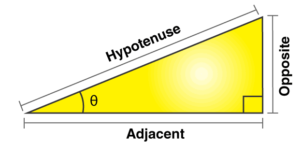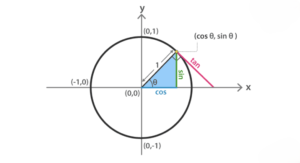Trigonometry

Understanding the Basics with interactive simulations
What is Trigonometry?
Trigonometry is a branch of mathematics that studies the relationships between the angles and sides of triangles. The word “trigonometry” comes from the Greek words “trigonon” (meaning triangle) and “metron” (meaning measure). It’s a fundamental concept that has practical applications in fields like physics, engineering, astronomy, and even in everyday problem-solving.
The Triangle and Its Angles
A triangle is a three-sided polygon. The most important thing to remember is that the sum of the angles in any triangle is always 180°. In trigonometry, we are particularly interested in right-angled triangles, where one of the angles is exactly 90°.

The Right-Angled Triangle
A right-angled triangle has three sides:
- Hypotenuse: The longest side, opposite the right angle.
- Adjacent: The side next to the angle of interest.
- Opposite: The side opposite the angle of interest.
Trigonometric Ratios
Trigonometry revolves around three main ratios derived from the sides of a right-angled triangle. These ratios are:
- Sine (sin): The ratio of the length of the opposite side to the hypotenuse.
Sin𝜭 = OppositeHypotenuse
- Cos (Cosine): The ratio of the length of the adjacent side to the hypotenuse.
Cos𝜭 = adjacent Hypotenuse
- Tan (tangent): The ratio of the length of the opposite side to the adjacent side.
Tan𝜭 = OppositeAdjacent
Unit Circle
The concept of unit circle helps us to measure the angles of cos, sin and tan directly since the center of the circle is located at the origin and radius is 1. Consider theta be an angle then,

Interactive Simulations
To help you better understand trigonometric ratios and their relationships with angles, we’ve prepared simulations that allow you to visualize these concepts. These simulations let you:
Adjust the angles of a triangle and see how the sine, cosine, and tangent ratios change.
Observe the effect of changing the side lengths on the trigonometric ratios.
Experiment with different triangle configurations to see the practical application of trigonometry in real-time.
These interactive tools are designed to make learning trigonometry more engaging and intuitive. By experimenting with the simulations, you can gain a deeper understanding of how trigonometric ratios work and how they are used to solve problems.
Real-Life Applications
Trigonometry might sound theoretical, but it’s incredibly practical. For example:
- Architecture: Architects use trigonometry to calculate structural load, roof slopes, ground surfaces, and many other aspects.
- Navigation: Pilots and sailors use trigonometry to navigate and find distances between two points.
- Engineering: Engineers use trigonometry to design and analyze structures, mechanical systems, and more.
Example Problem
Imagine you’re trying to find the height of a tree. You stand 30 meters away from it and measure the angle of elevation to the top of the tree as 45°. You can use the tangent ratio to find the height of the tree:
tan(45°) = Height of tree30
1 = Height of tree30
So, the height of the tree is 30m.
Practice Questions
- If the sine of an angle in a right-angled triangle is 0.5 and the hypotenuse is 10 meters, what is the length of the opposite side?
- You’re standing 50 meters away from a building, and the angle of elevation to the top of the building is 30°. How tall is the building?
Summary
Trigonometry is a powerful tool that helps us solve problems involving triangles, especially right-angled ones. By understanding and applying the trigonometric ratios—sine, cosine, and tangent you can calculate unknown angles or sides in various real-world situations. With the added benefit of interactive simulations, learning trigonometry becomes not only easier but also more fun and engaging.





Responses